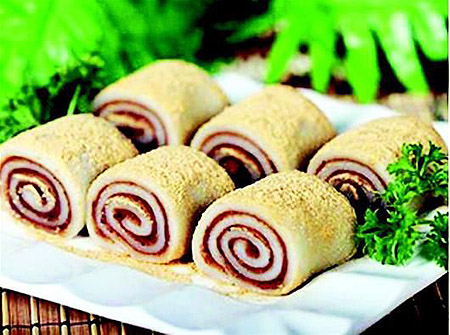 |
|
[Photo/chinadaily.com.cn]
|
Soybean flour cake, or lü da gunr, is a famous snack in Beijing.
The dessert can be traced back to the Manchu-led Qing Dynasty (1644-1911) when the leader of the Uygur ethnic group in Xinjiang married his sister to Qing Emperor Qianlong (1711-1799). Spirited away to the Forbidden City, the Uygur girl, known as the Fragrant Concubine due to her natural floral scent, was disconsolate no matter what efforts the emperor made to entertain her. Hence, Qianlong ordered the cooks in his palace to make thousands of delicacies, and promised a generous reward to the one who could please his consort. The imperial chefs tried their best but all failed. The emperor had no choice but to ask the girl’s fellow Uygurs in Xinjiang to bring some Islamic specialities.
Emperor Qianlong never expected that his imperial consort once had a secret lover, who was heartbroken when separated from his beloved. When he heard the news of the emperor’s appeal, the lovesick man traveled to Beijing and brought with him the steamed glutinous rice ball, lü da gunr. The Chinese name of this sweet snack translates as “rolling donkey.” This is because when the rice ball is rolled in soybean flour it looks like a donkey rolling on the ground, kicking up a cloud of dust. The moment the imperial consort saw the cake she realized that her lover was close by and so ate it with great delight.
Emperor Qianlong was also pleased and made the dish a daily treat. The soybean flour cake became famous and later gained popularity among Qing rulers and commoners alike.
To cook:
Mix glutinous rice powder with water to make a dough. Place the dough on a baking tray greased with sesame oil and steam in the oven for about 20 minutes, five to 10 minutes on a high heat, and then reduced heat.
Meanwhile, stir-fry the soybean flour for about five minutes until golden.
Mix red bean paste with water.
Dust a clean surface with the soybean flour.
Lay the steamed glutinous rice dough on the soybean flour and roll flat. Use plastic wrap to prevent the dough from sticking to the rolling pin. Spread the red bean paste over the dough and roll up.
Cut the rolled-up dough into pieces and cover each section with more soybean flour.
We Recommend:
